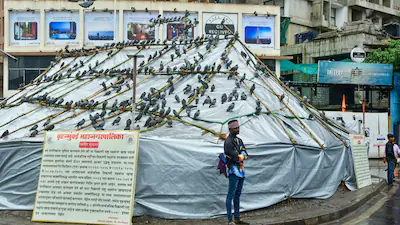August 5, 2025: The Brihanmumbai Municipal Corporation (BMC) has recently taken a decisive step in its ongoing effort to address the health hazards associated with pigeon feeding in Mumbai. On Sunday, the civic body covered the iconic Kabutarkhana in Dadar—a Grade II heritage structure and one of the city’s most prominent pigeon feeding spots—with a tarpaulin sheet, effectively restricting public access to the area.
This action follows a recent observation by the Bombay High Court that feeding large congregations of pigeons constitutes a public nuisance and poses significant health risks. The court directed the BMC to file FIRs against individuals continuing the practice, while clarifying that although the heritage structures would remain intact, feeding pigeons there would no longer be permitted.
The move has ignited a political storm. Maharashtra minister Mangal Prabhat Lodha criticised the BMC for interfering with what he described as a cultural and religious tradition, while the Maharashtra Navnirman Sena (MNS) called for a rational rather than emotional response to the situation.
Kabutarkhanas have been an intrinsic part of Mumbai’s landscape for nearly a century. The Dadar Kabutarkhana, for instance, dates back to 1933 and holds Grade II heritage status. These structures became popular thanks to Gujarati and Jain businessmen, who established dedicated feeding spots across the city—typically near temples, markets, and railway stations. Over time, these sites evolved into more than mere feeding points. They became social hubs, particularly for the Jain community, where feeding pigeons was regarded as both a spiritual ritual and an expression of compassion.
The practice has profound religious significance in Jainism, embodying the values of non-violence and charity. Feeding pigeons is believed to accrue religious merit, particularly on Amavasya (new moon days), when the ritual is considered most auspicious. For many families, it is also a way to honour ancestors. Similar beliefs exist among other communities, including Hindus and Muslims, who occasionally participate in the practice.
However, what began as an act of piety has gradually turned into a public health concern. Mumbai’s pigeon population has soared, largely fuelled by human feeding. The 2023 State of India’s Birds report highlighted a sharp rise in urban pigeon numbers, with serious implications for both health and infrastructure. Pigeon droppings and feathers harbour pathogens linked to respiratory illnesses such as hypersensitivity pneumonitis and histoplasmosis, which can cause severe complications in vulnerable individuals. In addition, acidic droppings have been blamed for corroding heritage structures, while scattered grain and flocks of birds have created safety hazards in high-traffic areas like Dadar.
In response, the Bombay High Court recently ordered the BMC to curb the practice by covering kabutarkhanas and filing FIRs against offenders. Between mid-July and early August, the civic body fined over 140 individuals and sealed several feeding spots. The ban has sparked protests from the Jain community, with more than a thousand demonstrators assembling at the Gateway of India to demand its reversal. Chief Minister Devendra Fadnavis has now intervened, calling for a meeting to find common ground between religious sentiments and public health priorities.
Source: News 18





